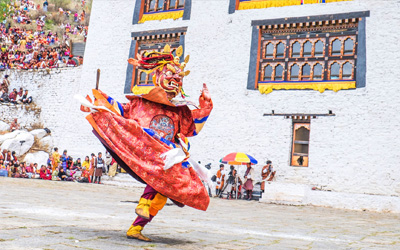Duration: 8 days
Exit and Entry: Paro
Venue: Paro Dzong Courtyard
Summary
Paro Tshechu is one of the biggest festivals in the Bhutanese calendar and was started by Zhabdrung Ngawang Namgyal, and Penlop Rigzin Nyingpo during the consecration of Paro Dzong in 1644. The festival is observed in three parts – the pre-festival rituals on the first day, ceremonies on the second day inside the Paro Dzong, and the main festival at the festival ground for three days. Bhutanese from all walks of life in their finery come to attend the five-day festival.
A special event in all Tsechus is the unfurling of the Thongdrol, meaning “Liberation at Sight.” This comes from the belief that seeing an aesthetically proportioned Buddhist image plants a seed of enlightenment in the viewer’s heart. That seed matures into the liberation of one’s mind and frees us from endless rebirths of suffering.
Thongdrol also means large silk appliqué thangkas (painting) that are displayed for a few hours during important religious ceremonies in Bhutan.
The sacred Thongdrol of Guru Rinpoche is displayed early in the morning on the last day of the Tshechu. On such occasion, the festival venue fills with people at dawn in freezing cold.
Punakha Tsechu
Duration: 6 days
Entry and Exit: Paro
Venue: Punakha
Summary:
One of the biggest festivals in the Bhutanese calendar, the Punakha Tshechu is held every year, sometime in February or March. The most important display during the five-day festival is the re-enactment of the Tibetan invasion of Bhutan in 1639. In this theatrical display, a mock throwing of a relic to the Mochu River is dramatized along with a group performance by more than a hundred people dressed as warriors, popularly known as “Pazaps.”.
This performance tells the story of 17th century Bhutan, when the Bhutanese were under siege by Tibetan forces. Devoid of a standing army of its own, the duty to hold the Fort fell on the local militiamen called “Pazaps”, from the eight great villages (Tshogchens) of Thimphu. The invaders were routed.
To celebrate the victory, Shabdrung Ngawang Namgyal introduced the Punakha Drubchen. The 17th century scene is re-enacted during the Drubchen with local men dressed as “Pazaps”.
